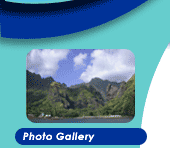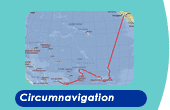January
24, 2001
In Transit
from El Roque, Los Roques, Venezuela to Pirate’s Cay
Pan Pan in Los Roques
By Lois and Gunter  
We completed our tour of the town and light provisioning at Puerto
El Roque yesterday too late to depart, so we anchored overnight in the
bay. After a leisurely breakfast and listening to Davy Jones weather
forecast on the Caribbean Net, we were ready to depart for Pirate’s
Cove, where we understood there would be more great snorkeling, and
we could purchase some fresh fish or lobster. We pulled anchor
at 10:00 AM and motored across the bay, a 20-knot ESE wind right on
the nose. Anchoring at the little cove was difficult in the wind
and swells, and to increase the difficulty, there were reefs on either
side of the designated anchorage.
We dropped the hook and pulled back the boat to set the anchor. The
anchor did not hold. Using both engines to provide control in
the swells, we dragged the anchor back away from the island into deeper
waters. We wanted to stay clear of the dangerous reefs. At
one point, the anchor was hanging straight down, so we stopped the engines
and tried to hoist it. Our efforts were in vain; the windlass
could not lift the anchor!
It felt as if the anchor was hooked onto something, perhaps an underground
cable. Our chart didn’t show a cable, but that was not surprising. Much
of Los Roques is not even charted at all. Within minutes we realized
that we were moving! We were drifting slowly towards the main
island of El Roque, with the anchor hanging straight down.
O.K. Throw out the cable idea. Now we knew that there must be
a very heavy weight attached to the anchor, possibly a rock or piece
of coral. One option would be to cut the anchor line and drop the anchor
for possible later recovery after attaching the line to a float. But
we wanted to get underway and out of the confined space so we decided
to place a “PAN PAN” call on the VHF to the Los Roques Coast Guard
Station. Gunter and Richard had met them earlier during our check
in and they had seemed friendly enough. (PAN PAN is a mariner’s distress
call; it is used when there is no danger of losing lives or the boat;
in a desperate case, one would put through a MAYDAY call.) We
could see Puerto El Roque from where we were, so we knew that help could
come quickly.
The coast guard did responded quickly and, within 10 minutes, sent
out an inflatable with about 6 good-looking young men and diving gear.
Some of them boarded Pacific Bliss. Others reached out from their
inflatable and shook the anchor line violently. This shaking apparently
dislodged the heavy object on the anchor and set the anchor free.
We all breathed a sigh of relief.
But there was more to come. The anchor was not yet up.
As Gunter, Richard and the Venezuelans hoisted the anchor, one of the
young men dislodged the anchor chain from the windlass by accident.
The anchor dropped all the way down until the bitter end, which
was fortunately fastened to the windlass.
So now we were solidly anchored in 120 feet of water and had a hard
time freeing the anchor from the ocean floor. One diver went down to
free the anchor. After much sweating, we could bring the anchor up all
the way. Note that the windlass works only on the chain, whereas the
last 25 feet of the anchor rode is a rope, which needed to be hauled
up by hand.
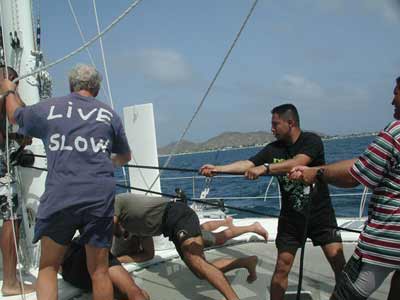
Live Slow? Not today!
Pulling up the anchor rode.
Four or five of the Coast Guard men accompanied us on Pacific Bliss
back to Puerto El Roque. We anchored again near the Coast Guard
Station, at the little port town we had not expected to see again. We
offered the guys our thanks and a well-deserved tip, and asked them
whether they wanted us to dinghy them to shore. “No thanks,” they
said, and quickly dove into the water, one after the other, showing
off as they swam with powerful breast strokes to the beach near the
Station. Phyllis and Lois were duly impressed.
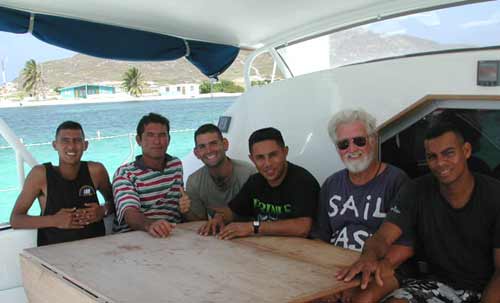
Gunter with Venezuelan Coast Guard
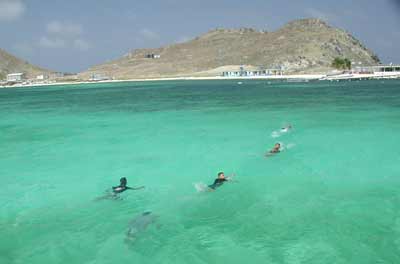
Swimming Back
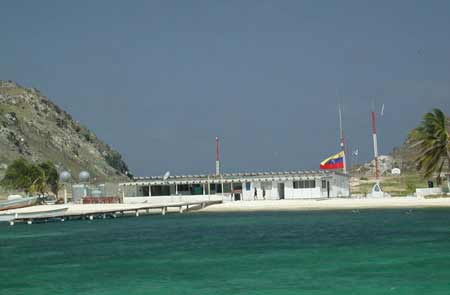
Coast Guard Station
We reconnoitered over a cockpit lunch. We decided that Pirates
Cove had bad karma and that we would set sail to another island called
Carenero. It was not an easy passage. We wound around
through breaking reefs to a waypoint between Naranqui and Crasqui, then
between Los Canquesas and Sarqui, and finally between Yanqui and Carenero,
where we would spend the next day snorkeling and relaxing.
One should wind through this type of passage with the mid-day sun overhead,
watching carefully, through polarized sunglasses, for coralheads.
The afternoon sun was getting disarmingly lower as we carefully pushed
on through the shallow passages.
Finally, we were anchored in a beautiful, secluded bay, where we could
relax from the harrowing day. Gunter dug for four cold Heinekens
and handed them out at the net to celebrate our arrival. But it
is never over ‘til it’s over. And this day of bad luck was not
over!
As we celebrated, one empty can somehow fell into the anchor box where
it lodged deep down into the area where all the control sheets of the
sails were going over rollers. We could not leave this untended,
because we did not want any future jamming of sheets. Each one
of us tried to retrieve the can. Lois, because she had small hands.
Phyllis, because she didn’t mind the blood rushing to her head.
Gunter, just because he had to. Then Richard, who claimed that
it was his can that did the damage, dove deep down into the anchor locker
up to his belly while we held onto his legs! After multiple
tries, he managed to retrieve the can.
However, all’s well that ends well. The anchorage at Carenero
rewarded us for the trials of the day with tranquillity, beauty and
a marvelous sunset.
journal31.html |





